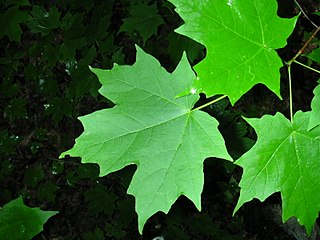 W
WAcer saccharum, the sugar maple, is a species of flowering plant in the soapberry and lychee family Sapindaceae. It is native to the hardwood forests of eastern Canada, from Nova Scotia west through southern Quebec, central and southern Ontario to southeastern Manitoba around Lake of the Woods, and northcentral and northeastern United States, from Minnesota eastward to Maine and southward to northern Virginia, Tennessee and Missouri. Sugar maple is best known for being the primary source of maple syrup and for its brightly colored fall foliage. It may also be known as "rock maple", "sugar tree", "birds-eye maple", "sweet maple", "curly maple", or "hard maple", particularly when referring to the wood.
 W
WAsimina triloba, the American papaw, pawpaw, paw paw, or paw-paw, among many regional names, is a small deciduous tree native to the eastern United States and Canada, producing a large, yellowish-green to brown fruit. It belongs to the genus Asimina in the same plant family as the custard-apple, cherimoya, sweetsop, ylang-ylang, and soursop.
 W
WBlueberries are perennial flowering plants with blue or purple berries. They are classified in the section Cyanococcus within the genus Vaccinium. Vaccinium also includes cranberries, bilberries, huckleberries and Madeira blueberries. Commercial blueberries—both wild (lowbush) and cultivated (highbush)—are all native to North America. The highbush varieties were introduced into Europe during the 1930s.
 W
WThe boysenberry is a cross among the European raspberry, European blackberry, American dewberry, and loganberry.
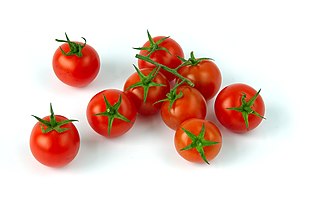 W
WThe cherry tomato is a type of small round tomato believed to be an intermediate genetic admixture between wild currant-type tomatoes and domesticated garden tomatoes. Cherry tomatoes range in size from a thumbtip up to the size of a golf ball, and can range from spherical to slightly oblong in shape. Although usually red, other colours such as yellow, green, and black also exist. Those shaped like an oblong share characteristics with plum tomatoes and are known as grape tomatoes. The cherry tomato is regarded as a botanical variety of the cultivated berry, Solanum lycopersicum var. cerasiforme.
 W
WThe cocoa bean or simply cocoa, which is also called the cacao bean or cacao , is the dried and fully fermented seed of Theobroma cacao, from which cocoa solids and cocoa butter can be extracted. Cocoa beans are the basis of chocolate, and Mesoamerican foods including tejate, an indigenous Mexican drink that also includes maize.
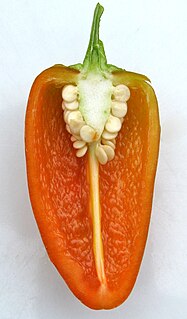 W
WThe Fresno chile or Fresno chili pepper is a medium-sized cultivar of Capsicum annuum. It should not be confused with the Fresno Bell pepper. It is often confused with the jalapeño pepper but has thinner walls, often has milder heat, and takes less time to mature. It is, however, a New Mexico chile, which is genetically distinct from the jalapeño and it grows point up, rather than point down as with the jalapeño. The fruit starts out bright green changing to orange and red as fully matured. A mature Fresno pepper will be conical in shape, 2 inches long, and about 1 inch in diameter at the stem. The plants do well in warm to hot temperatures and dry climates with long sunny summer days and cool nights. They are very cold-sensitive and disease resistant, reaching a height of 24 to 30 inches.
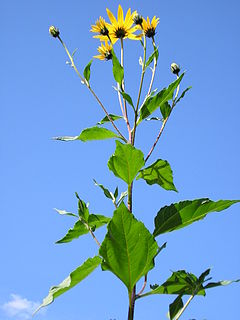 W
WThe Jerusalem artichoke, also called sunroot, sunchoke, wild sunflower, topinambur, or earth apple, is a species of sunflower native to central North America. It is cultivated widely across the temperate zone for its tuber, which is used as a root vegetable.
 W
WThe loganberry is a hybrid of the North American blackberry and the European raspberry.
 W
WThe marionberry is a cultivar of blackberry developed by the USDA ARS breeding program in cooperation with Oregon State University. A cross between the 'Chehalem' and 'Olallie' varieties, it is the most common form of blackberry cultivated. It accounts for over half of all blackberries produced in Oregon.
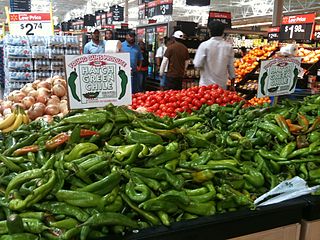 W
WNew Mexico chile or New Mexican chile is a cultivar group of the chile pepper from the US state of New Mexico, first grown by Pueblo and Hispano communities throughout Santa Fe de Nuevo México. These heritage chile plants were used to develop the modern New Mexico chile peppers by horticulturist Dr. Fabián García and his students, including Dr. Roy Nakayama, at what is now New Mexico State University in 1894. New Mexico chile, which typically grows from a green to a ripened red, is popular in the cuisine of the Southwestern United States, the broader Mexican cuisine, and Sonoran and Arizona cuisine, and an integral staple of New Mexican cuisine. Chile is one of New Mexico's state vegetables, and is referenced in the New Mexico state question "Red or Green?".
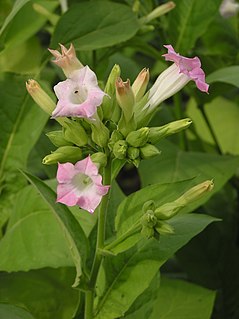 W
WNicotiana tabacum, or cultivated tobacco, is an annually-grown herbaceous plant. It is found in cultivation, where it is the most commonly grown of all plants in the genus Nicotiana, and its leaves are commercially grown in many countries to be processed into tobacco. It grows to heights between 1 and 2 meters. Research is ongoing into its ancestry among wild Nicotiana species, but it is believed to be a hybrid of Nicotiana sylvestris, Nicotiana tomentosiformis, and possibly Nicotiana otophora.
 W
WVaccinium corymbosum, the northern highbush blueberry, is a North American species of blueberry which has become a food crop of significant economic importance. It is native to eastern Canada and the eastern and southern United States, from Ontario east to Nova Scotia and south as far as Florida and eastern Texas. It is also naturalized in other places: Europe, Japan, New Zealand, the Pacific Northwest of North America, etc. Other common names include blue huckleberry, tall huckleberry, swamp huckleberry, high blueberry, and swamp blueberry.
 W
WThe pinyon or piñon pine group grows in southwestern North America, especially in New Mexico, Arizona, and Utah. The trees yield edible nuts, which are a staple food of Native Americans, and widely eaten as a snack and as an ingredient in New Mexican cuisine. The name comes from the Spanish pino piñonero, a name used for both the American varieties and the stone pine common in Spain, which also produces edible nuts typical of Mediterranean cuisine. Harvesting techniques of the prehistoric American Indians are still used today to collect the pinyon seeds for personal use or for commercialization. The pinyon nut or seed is high in fats and calories.
 W
WPouteria sapota, the mamey sapote, is a species of tree native to Mexico and Central America. The tree is also cultivated in the Caribbean. Its fruit is eaten in many Latin American countries. The fruit is made into foods such as milkshakes and ice cream.
 W
WVaccinium darrowii, with the common names Darrow's blueberry, evergreen blueberry, scrub blueberry, or southern highbush blueberry, is a species of Vaccinium in the blueberry group.
 W
WSweet corn is a variety of maize with a high sugar content. Sweet corn is the result of a naturally occurring recessive mutation in the genes which control conversion of sugar to starch inside the endosperm of the corn kernel. Unlike field corn varieties, which are harvested when the kernels are dry and mature, sweet corn is picked when immature and prepared and eaten as a vegetable, rather than a grain. Since the process of maturation involves converting sugar to starch, sweet corn stores poorly and must be eaten fresh, canned, or frozen, before the kernels become tough and starchy.
 W
WVaccinium angustifolium, commonly known as the wild lowbush blueberry, is a species of blueberry native to eastern and central Canada and the northeastern United States, growing as far south as the Great Smoky Mountains and west to the Great Lakes region.
 W
WVaccinium corymbosum, the northern highbush blueberry, is a North American species of blueberry which has become a food crop of significant economic importance. It is native to eastern Canada and the eastern and southern United States, from Ontario east to Nova Scotia and south as far as Florida and eastern Texas. It is also naturalized in other places: Europe, Japan, New Zealand, the Pacific Northwest of North America, etc. Other common names include blue huckleberry, tall huckleberry, swamp huckleberry, high blueberry, and swamp blueberry.
 W
WVaccinium darrowii, with the common names Darrow's blueberry, evergreen blueberry, scrub blueberry, or southern highbush blueberry, is a species of Vaccinium in the blueberry group.
 W
WVaccinium macrocarpon is a North American species of cranberry of the subgenus Oxycoccus and genus Vaccinium.
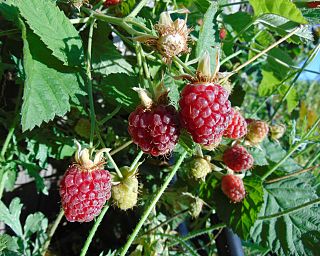 W
WThe youngberry is a complex hybrid between three different berry species from the genus Rubus: raspberry, blackberry, and dewberry of the Rose family. The berries of the plant are eaten fresh or used to make juice, jam, and in recipes.
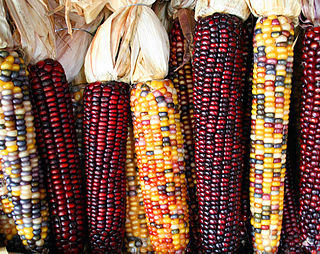 W
WZea is a genus of flowering plants in the grass family. The best-known species is Z. mays, one of the most important crops for human societies throughout much of the world. Several wild species are commonly known as teosintes and are native to Mesoamerica.
 W
WWild rice is four species of grasses forming the genus Zizania, and the grain that can be harvested from them. The grain was historically gathered and eaten in North America and China; the grain is eaten less in China, where the plant's stem is used as a vegetable.